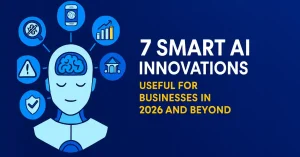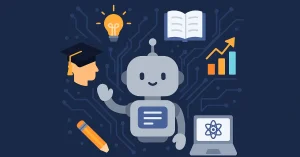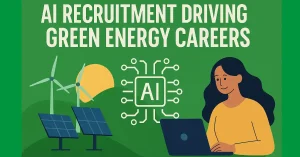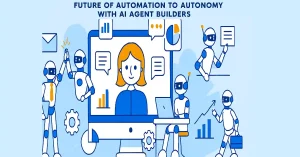AI is evolving at a rapid pace. There is a demand for faster, more efficient, and more adaptable computing solutions. This is where artificial intelligence field-programmable gate arrays (FPGAs) become relevant. It combines hardware programmability with parallel processing. This attribute makes them ideal for accelerating AI workloads. They are increasingly exerting their influence in this field. This report explores FPGA in AI. It covers their benefits, uses, and future potential. It also addresses their challenges and limits.
In 2025, the global FPGA market is valued at approximately USD 11-14 billion and is projected to reach USD 19-44 billion by 2030-2035 with a CAGR of 9-15%, fueled by AI acceleration, edge computing, and 5G/6G deployments. Artificial intelligence FPGA technology combines flexibility and high performance, being up to 20 times faster than CPUs for real-time tasks, using 38% less power than older models in edge AI, and allowing for custom speed improvements. Major players, including AMD (Xilinx Versal), independent Altera (Agilex series in full production), Lattice (low-power for TinyML), and Intel/Microchip, drive innovation.
This overview, updated for 2025, includes advantages, applications (edge AI, autonomous vehicles), comparisons (vs GPU/ASIC), challenges, and emerging trends like contextual AI and quantum-resistant designs.
What are FPGAs?
FPGAs are semiconductor devices. You can program them to run complex digital tasks. They are unlike traditional processors. They offer a customizable hardware platform. You can tailor it to specific tasks. This flexibility has major benefits. It improves speed, latency, and power efficiency. So, they are ideal for the demanding workloads of AI applications.
In 2025, modern FPGAs like Altera’s Agilex 5 (2.5x density boost, DDR5 up to 5,600 MT/s) and AMD’s Versal series integrate AI engines, hard IP blocks (DSPs, transceivers), and reconfigurable fabric for heterogeneous computing. Node sizes shrink to ≤16 nm (15.1% CAGR segment), enabling billions of transistors for massive parallelism in neural networks.
| FPGA Generation | Key Features 2025 | Vendors |
|---|---|---|
| Agilex (Altera) | AI fabric, PQC secure boot | Independent Altera |
| Versal (AMD) | AI Engines, hybrid CPU-FPGA | AMD/Xilinx |
| PolarFire (Microchip) | Low-power, radiation-tolerant | Microchip |
Advantages of FPGAs in AI
Custom Hardware Acceleration
FPGAs excel at providing custom hardware acceleration, a crucial aspect of AI applications. This means much lower latency and better energy efficiency than general-purpose processors. For instance, Microsoft discovered that FPGAs reduced image classification latency by a factor of 20 compared to CPUs. This evidence shows their real-time processing power.
In 2025, advancements like Lattice’s sensAI/mVision toolkits enable 99%+ precision in edge inference, while Altera’s Visual Designer Studio cuts compile times for rapid prototyping. Custom pipelines optimize for specific models (e.g., CNNs, transformers), yielding 1.9x performance gains.
Flexibility and Reconfigurability
One of the most compelling features of FPGAs is their flexibility. Their logic is reconfigurable. It lets developers update the hardware. They can adapt to evolving AI models and workloads. This adaptability is vital in the fast-changing AI research field.
2025 sees open-source ecosystems and high-level synthesis (HLS) tools democratizing development, reducing HDL barriers. Dynamic partial reconfiguration allows runtime updates without downtime, ideal for multi-tenant edge AI.
Parallel Processing Capabilities
FPGAs excel at parallel processing. They can handle many data points or batches at once. This ability is key to maximizing AI algorithm performance. They often use massive datasets and complex computations.
With integrated DSP blocks and AI tensors (e.g., AMD AI Engines), FPGAs achieve high TOPS/W for inference, outperforming GPUs in deterministic latency-critical tasks.
Low Power Consumption
Power efficiency is crucial for many AI apps. This is true for edge computing and mobile devices. FPGAs excel here. They use much less power than GPUs. This makes them ideal for deploying AI at the edge.
2025 low-power leaders like Lattice/Microchip PolarFire consume 38–50% less, enabling TinyML on wearables/battery devices.
Applications of FPGAs in AI
Edge Computing
It has low latency and is power-efficient. So, they are excellent for edge computing, where real-time processing is crucial. They power a wide range of applications, including:
- Real-time Object Detection: It can process video from security cameras to detect objects in real time. They complete the task with outstanding efficiency. This boosts security and surveillance systems.
- Edge-based Voice Assistants: Its enable quick, accurate speech recognition in voice assistants. This improves the user experience by making it more responsive and seamless.
In 2025, contextual/edge AI surges: Lattice FPGAs for human-machine interfaces and AMD Kria for robotics (real-time sensor fusion). Applications expand to smart cities (anomaly detection) and industrial IoT (predictive maintenance).
Autonomous Vehicles
In the race for self-driving cars, FPGAs play a vital role. They enable rapid processing of sensor data from cameras, LiDAR, and radar. This allows for real-time decisions for safe navigation and collision avoidance.
2025: ADAS/electrification drives 13.4% CAGR; FPGAs handle multi-sensor fusion with low latency.
Medical Imaging
FPGAs are changing medical imaging. They enable faster, more accurate diagnoses. They can process vast amounts of medical data and images in real time. They assist doctors in making quick decisions, even in remote areas.
AI-accelerated ultrasound/CT with FPGAs reduces processing time 50%, aiding telemedicine.
Data Centers
Data centers are using FPGAs more to speed up AI tasks, including
- Network Routing: FPGAs optimize traffic flow in data centers. They boost efficiency and reduce latency.
- Data Storage: FPGAs speed up data storage and retrieval. This boosts large-scale data analytics and machine learning.
2025: Hyperscalers deploy for inference (latency/power over throughput); Altera Agilex for cloud AI.
Additional 2025 applications: TinyML (wearables), quantum-resistant crypto, 8K video, space (radiation-tolerant).
FPGA vs. GPU vs. ASIC for AI: A Balanced Perspective
GPUs have long dominated AI model training. FPGAs are a strong alternative, especially for some workloads. ASICs (e.g., TPUs) offer peak efficiency but lack flexibility. The following table provides a balanced comparison:
| Aspect | FPGAs | GPUs | ASICs |
|---|---|---|---|
| Latency | Lowest (deterministic) | Higher | Lowest (fixed) |
| Power Consumption | Low (38-50% savings edge) | High | Lowest |
| Flexibility | Highest (reconfigurable) | Medium (CUDA ecosystems) | None (fixed design) |
| Development Ease | Improving (HLS, open-source) | Easiest | Hardest (long cycles) |
| Best For | Inference, edge, real-time | Training, parallel | High-volume inference |
| Cost 2025 | Mid-range | High | High initial, low volume |
FPGAs shine in hybrid/edge (reprogram for new models), GPUs in training, ASICs in scale (e.g., Google TPUs).
Challenges and Limitations of FPGAs in AI
Despite their numerous advantages, FPGAs also present some challenges:
- Programming Complexity: FPGA development needs knowledge of HDLs, like Verilog or VHDL. These are harder than traditional programming. 2025 mitigation: HLS, Visual Designer Studio reduce barriers.
- Limited Ecosystem: The AI software for FPGAs is less developed than that for GPUs. There are fewer pre-built libraries and tools. This may increase development time. Growing: Vitis AI, OpenVINO support.
Additional: Higher upfront cost vs GPUs for training; density/power trade-offs in ≤16nm.
Future Potential and Innovations
The convergence of AI and FPGA technology is sparking exciting innovations.
- TinyML Applications: TinyML, which brings AI to resource-constrained devices, is gaining traction. FPGAs have low power usage and high performance. They can drive TinyML adoption in wearable health trackers and smart home devices.
- Quantum-Resistant Cryptography: As quantum computing advances, traditional encryption methods become vulnerable. FPGAs may help implement quantum-resistant cryptography. This will secure future communications.
- 8K Video Processing: 8K video needs high processing power due to its resolution. FPGAs are ideal for next-gen video tasks. They have high bandwidth and can process in parallel.
2025+: Contextual AI (Lattice for HMI), hybrid CPU-FPGA, software-defined FPGAs, open-source ecosystems. Market drivers: AIoT (80% projects incorporate AI), 6G prototyping.
Conclusion
In 2025, artificial intelligence FPGA technology stands at the forefront of efficient, adaptable computing, with a market surging to USD 11-14B amid AI/edge demands. From custom acceleration and low-power inference to innovations like Altera’s Agilex and AMD’s Versal, FPGAs bridge flexibility and performance where GPUs/ASICs fall short. Despite programming challenges, advancing tools and ecosystems promise broader adoption in TinyML, autonomous systems, and beyond. Embrace artificial intelligence with FPGAs for low-latency, energy-efficient AI—explore vendors like Altera and Lattice today to future-proof your applications.
FAQs
What is an artificial intelligence FPGA in 2025?
Artificial intelligence FPGA combines reconfigurable hardware with AI acceleration for low-latency, power-efficient tasks. Market is ~USD 11-14B, growing 9-15% CAGR to 2030+, driven by edge AI/TinyML. Vendors: Altera Agilex, AMD Versal.
Advantages of FPGAs over GPUs for AI?
FPGAs offer lower latency/power (38%–50% savings edge), reconfigurability for evolving models, and deterministic performance. FPGAs provide optimal inference and real-time performance, while GPUs excel in training. 2025: HLS tools ease development.
What are the key applications of artificial intelligence in FPGAs?
These applications include object detection in edge computing, sensor fusion in autonomous vehicles, medical imaging, and routing in data centers. In 2025, key applications will include TinyML wearables, contextual AI for human-machine interfaces (HMI), 8K video processing, and quantum-resistant cryptography.
FPGA market growth for AI in 2025?
Valued at USD 11-14B in 2025, projected at USD 19-44B by 2030-35 (CAGR 9-15%). The main drivers of growth include AI inference, 5G/6G technology, automotive advanced driver-assistance systems (ADAS), and edge Internet of Things (IoT) applications. Leaders: AMD, Altera (spin-off), and Lattice low-power.
What are the challenges of FPGAs in artificial intelligence?
The programming complexity of FPGAs, which is improving with HDL and HLS, presents challenges, especially due to the limited availability of pre-built libraries compared to GPUs. In 2025, solutions such as open-source tools and Visual Designer Studio will reduce development times, while the ecosystem for AI frameworks continues to grow.
Disclaimer: This article offers observations about artificial intelligence FPGA technology based on 2025 trends and data. It is not technical/financial advice. Consult experts for implementations. Author/NetworkUstad disclaims liability for decisions based on this content. Verify with vendors/sources.





